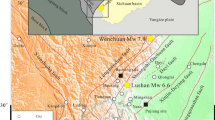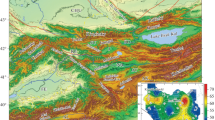Abstract
Based on the Chinese mainland GPS network (1994–1996), Fujian GPS network (1995–1997), cross fault deformation network (1982–1998), precise leveling network (1973–1980) and focal mechanism solutions of the recent several tens years, we synthetically and quantitatively studied the present-time crustal motion of the southeast coast of Chinese mainland—Fujian and its marginal sea. We find that this area with its mainland together moves toward SE with a rather constant velocity of 11.2±3.0 mm/a. At the same time, there is a motion from the Quanzhou bay pointing to hinterland, with a major orientation of NW, extending toward two sides, and with an average velocity of 3.0±2.6 mm/a. The faults orienting NE show compressing motions, and the ones orienting NW show extending motions. The present-time strain field derived from crustal deformation is consistent with seismic stress field derived from the focal mechanism solutions and the tectonic stress field derived from geology data. The principal stress of compression orients NW (NWW)—SE (SEE). Demarcated by the NW orienting faults of the Quanzhou bay and **jiang—Yongan, the crustal motions show regional characteristics: the southwest of Fujian and the boundary of Fujian and Guangdong are areas of rising, the northeast of Fujian are areas of sinking. The horizontal strain rate and the fault motion of the former are both greater than the later. The side-transferring motion of Hymalaya collision zone and the compression of the west pacific subduction zone affect the motion of the research area. The amount of motion affected by the former is larger than the later, but the former is homogeneous and the later is not, which indicates that the events of strong earthquakes in this region relate more directly with western pacific subduction zone.
Similar content being viewed by others
References
Chen Y T, Wang Z P, Huang Q T, et al. 1998. The fault-block basins, planes, inlets and earthquake in Fujian coast region. Crustal Deformation and Earthquake, 18(4): 55–61 (in Chinese)
Ding G Y ed-in-chief. 1991. Introduction of Lithosphere Dynamics of China. Bei**g, Seismological Press, 337–349 (in Chinese)
Ding X Z, Wu C Z. 1999. Study on the source mechanism of moderately strong earthquakes in Fujian and its coast. Crustal Deformation and Earthquake, 19(1): 95–97 (in Chinese)
Ding Y Z, Liang L. 1992. Earthquake dangers of geological structures in Bashi tectonic system. South China Seismological Journal, 12(2): 3–4 (in Chinese)
Gu G H, Wang R B, Sun D P, et al. 1997. The applications of vertical deformation intensity analysis in earthquake prediction. Earthquake, 17(4): 397–403 (in Chinese)
Haines A J, Holt W E. 1993. A procedure for obtaining the complete horizontal motion within zones of distributed deformation from the inversion of strain rate data. J Geophys Res, 98(137): 12057–12082
Jiang F, Dai L S. 1989. Focal and seismic stress field. In: Ma X Y ed-in-chief. Lithosphere Dynamics Atlas of China, 1968. Bei**g: China Cartographic Publishing House, 68 (in Chinese)
Lin J Z, Liang G Z, Zhao Y, et al. 1980. Focal mechanism and tectonic stress field of coastal Southeast China. Acta Seismologica Sinica, 2(3) 245–257 (in Chinese)
Liu C C, Yu S B. 1990. Vertical crustal movements in eastern Taiwan and their tectonic implications. Tectonophysics, 183: 111–119
Liu Y K, Guo F Y, Cheng Z H, et al. 1998. The present-time crustal vertical movements and fault activities. Crustal Deformation and Earthquake, 18(4): 68–73 (in Chinese)
Peng M F, Lin S M, Lin S. 1997. Study of the Taiwan Straits earthquake M=7.3 and the post-earthquake tendency. Earthquake, 17(2): 184–194 (in Chinese)
Shi Z L, Wang J, Zhang X D. 1995. The regional characteristics of seismic activities in China. Acta Seismologica Sinica, 8(1): 25–30
Wu Y, Shuai P, Shi S Y. 1997. Method of jointly convolutions of crustal horizontal movement velocity field using GPS surveying data and earthquake tensor. Crustal Deformation and Earthquake, 17(4): 11–16 (in Chinese)
Zhang C, **u J G, Qiu T Z, et al. 1993. Global Strong Earthquake Mechanism. Bei**g: Wanguo Academic Publishing House, 466 (in Chinese)
Zhou S Y, Zhang Y G, Ding G Y, et al. 1998. Preliminary studies of the modeling for the present-time movement of China hinterland blocks using GPS data. Acta Seismologica Sinica, 11(4): 403–412
Zhou S Y. 1999. Crustal deformation advancing towards 21st century: a new impetus to continental dynamics and earthquake prediction. Crustal Deformation and Earthquake, 19(1): 1–13
Author information
Authors and Affiliations
About this article
Cite this article
Zhou, SY., Shuai, P., Guo, FY. et al. A quantitative research for present-time crustal motion in Fujian Province, China and its marginal sea. Acta Seimol. Sin. 13, 75–83 (2000). https://doi.org/10.1007/s11589-000-0084-x
Received:
Revised:
Accepted:
Issue Date:
DOI: https://doi.org/10.1007/s11589-000-0084-x




